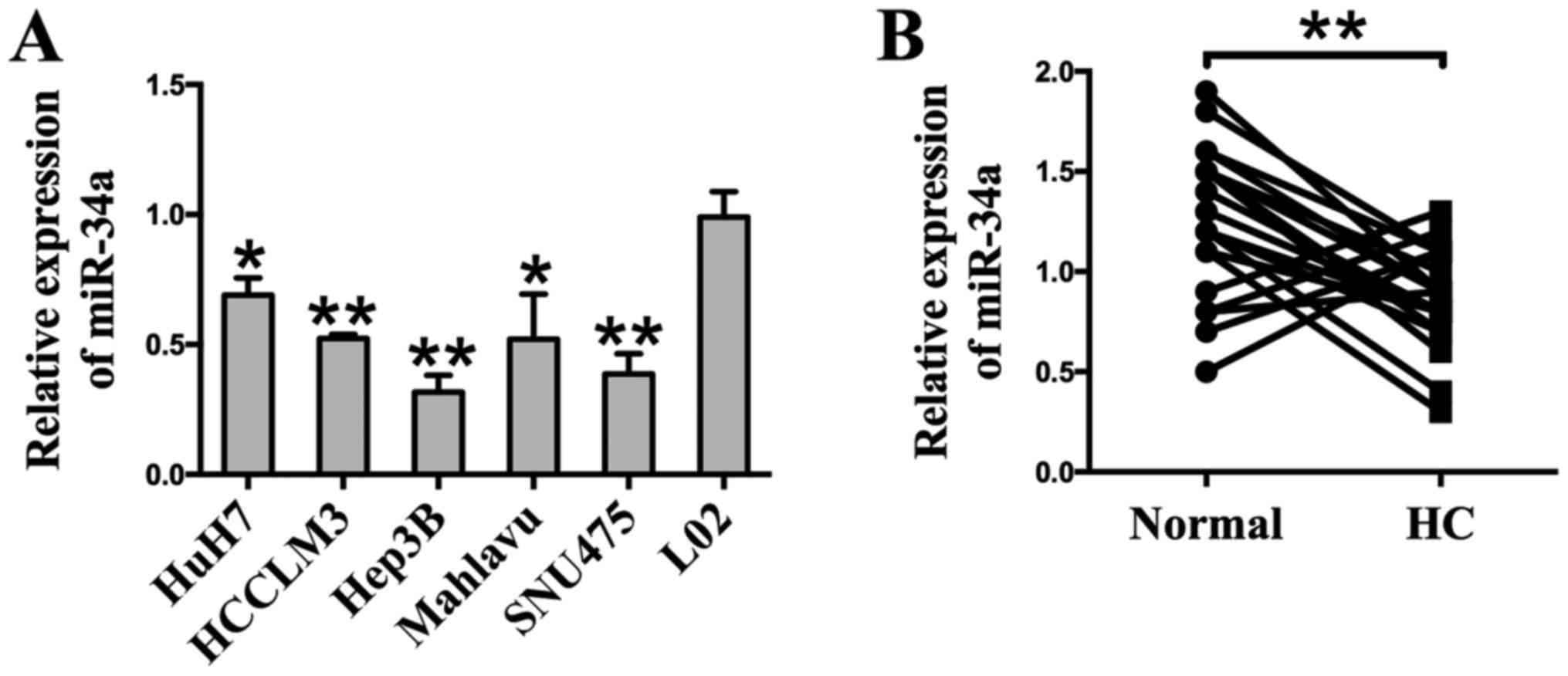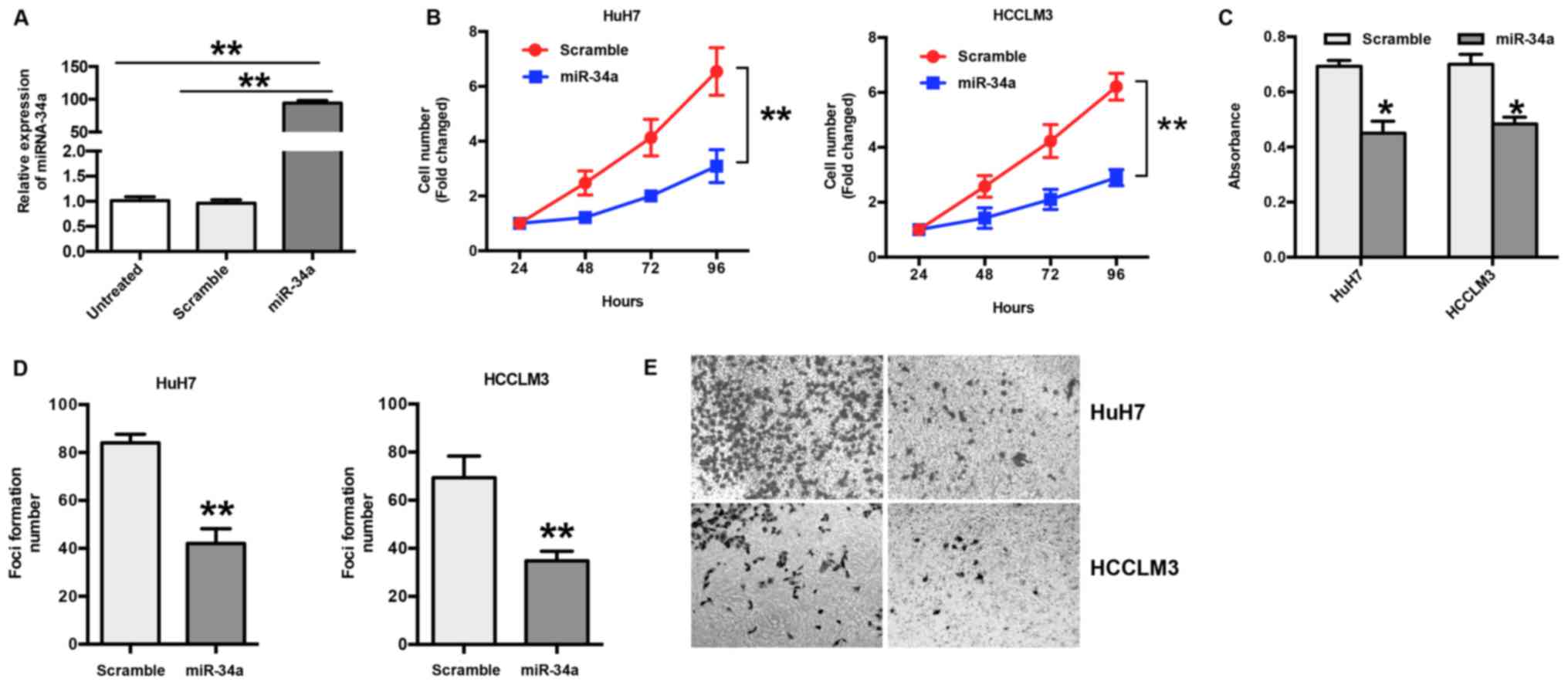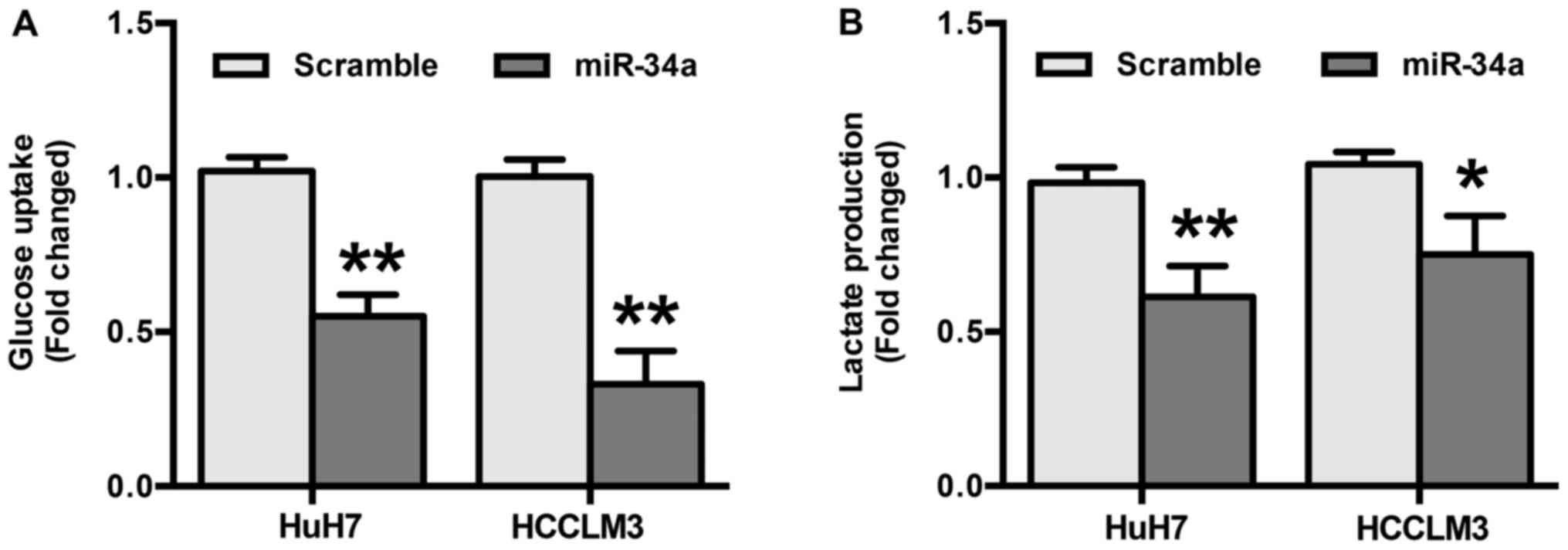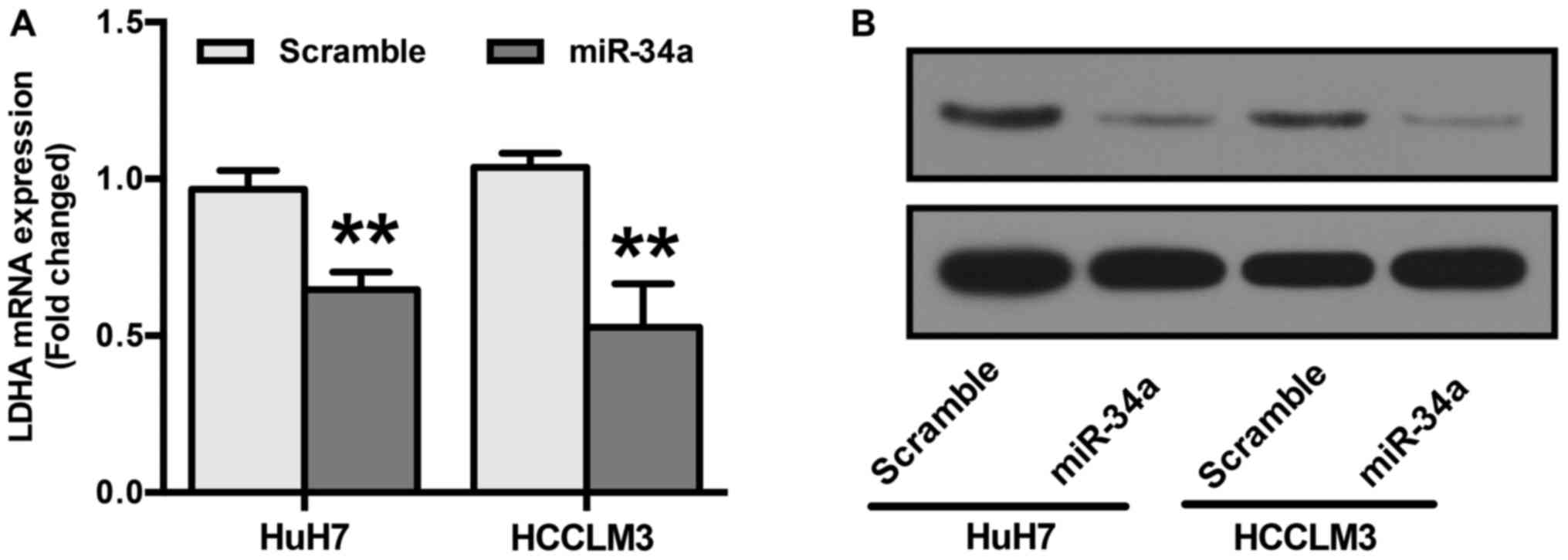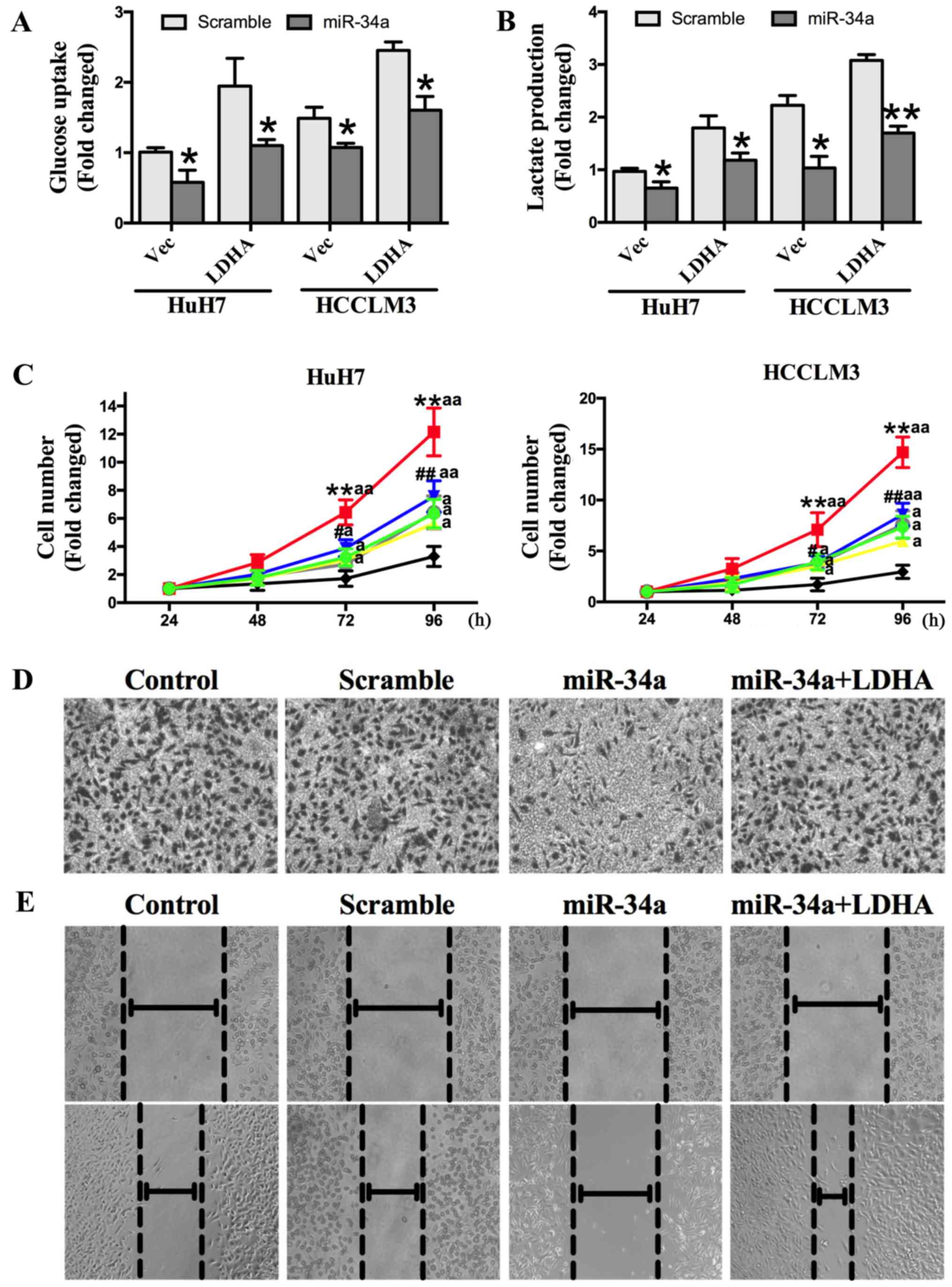|
1
|
Zhong GC, Liu Y, Chen N, Hao FB, Wang K,
Cheng JH, Gong JP and Ding X: Reproductive factors, menopausal
hormone therapies and primary liver cancer risk: A systematic
review and dose-response meta-analysis of observational studies.
Hum Reprod Update. 23:126–138. 2016. View Article : Google Scholar : PubMed/NCBI
|
|
2
|
Nio K, Yamashita T and Kaneko S: The
evolving concept of liver cancer stem cells. Mol Cancer. 16:42017.
View Article : Google Scholar : PubMed/NCBI
|
|
3
|
Rao CV, Asch AS and Yamada HY: Frequently
mutated genes/pathways and genomic instability as prevention
targets in liver cancer. Carcinogenesis. 38:2–11. 2017. View Article : Google Scholar : PubMed/NCBI
|
|
4
|
Rabinel P, Dousse D, Muscari F and Suc B:
Management of liver cancer. The Surgeon's point of view. Rep Pract
Oncol Radiother. 22:176–180. 2017. View Article : Google Scholar : PubMed/NCBI
|
|
5
|
Sia D, Villanueva A, Friedman SL and
Llovet JM: Liver cancer cell of origin, molecular class, and
effects on patient prognosis. Gastroenterology. 152:745–761. 2017.
View Article : Google Scholar : PubMed/NCBI
|
|
6
|
Stroehl YW, Letzen BS, van Breugel JM,
Geschwind JF and Chapiro J: Intra-arterial therapies for liver
cancer: Assessing tumor response. Expert Rev Anticancer Ther.
17:119–127. 2017. View Article : Google Scholar : PubMed/NCBI
|
|
7
|
Ma J, Lin J, Qian J, Qian W, Yin J, Yang
B, Tang Q, Chen X, Wen X, Guo H and Deng Z: miR-378 promotes the
migration of liver cancer cells by down-regulating Fus expression.
Cell Physiol Biochem. 34:2266–2274. 2014. View Article : Google Scholar : PubMed/NCBI
|
|
8
|
Pang F, Zha R, Zhao Y, Wang Q, Chen D,
Zhang Z, Chen T, Yao M, Gu J and He X: miR-525-3p enhances the
migration and invasion of liver cancer cells by downregulating
ZNF395. PLoS One. 9:e908672014. View Article : Google Scholar : PubMed/NCBI
|
|
9
|
Yin J, Bai Z, Song J, Yang Y, Wang J, Han
W, Zhang J, Meng H, Ma X, Yang Y, et al: Differential expression of
serum miR-126, miR-141 and miR-21 as novel biomarkers for early
detection of liver metastasis in colorectal cancer. Chin J Cancer
Res. 26:95–103. 2014.PubMed/NCBI
|
|
10
|
Guo W, Qiu Z, Wang Z, Wang Q, Tan N, Chen
T, Chen Z, Huang S, Gu J, Li J, et al: miR-199a-5p is negatively
associated with malignancies and regulates glycolysis and lactate
production by targeting hexokinase 2 in liver cancer. Hepatology.
62:1132–1144. 2015. View Article : Google Scholar : PubMed/NCBI
|
|
11
|
Liu HB, Hua Y and Jin ZX: Effects of
MicroRNA-132 transfection on the proliferation and apoptosis of
human liver cancer cells in vitro and in vivo. Zhongguo Yi Xue Ke
Xue Yuan Xue Bao. 37:30–36. 2015.PubMed/NCBI
|
|
12
|
Lu Z, Zhang W, Gao S, Jiang Q, Xiao Z, Ye
L and Zhang X: miR-506 suppresses liver cancer angiogenesis through
targeting sphingosine kinase 1 (SPHK1) mRNA. Biochem Biophys Res
Commun. 468:8–13. 2015. View Article : Google Scholar : PubMed/NCBI
|
|
13
|
Sun B, Li J, Shao D, Pan Y, Chen Y, Li S,
Yao X, Li H, Liu W, Zhang M, et al: Adipose tissue-secreted miR-27a
promotes liver cancer by targeting FOXO1 in obese individuals. Onco
Targets Ther. 8:735–744. 2015. View Article : Google Scholar : PubMed/NCBI
|
|
14
|
Dong P, Xiong Y, Watari H, Hanley SJ,
Konno Y, Ihira K, Yamada T, Kudo M, Yue J and Sakuragi N: miR-137
and miR-34a directly target Snail and inhibit EMT, invasion and
sphere-forming ability of ovarian cancer cells. J Exp Clin Cancer
Res. 35:1322016. View Article : Google Scholar : PubMed/NCBI
|
|
15
|
Chen W, Liu Y, Liang X, Huang Y and Li Q:
Chondroitin sulfate-functionalized polyamidoamine as a
tumor-targeted carrier for miR-34a delivery. Acta Biomater.
57:238–250. 2017. View Article : Google Scholar : PubMed/NCBI
|
|
16
|
Chen Y, Sun P, Guo X and Gao A: miR-34a, a
promising novel biomarker for benzene toxicity, is involved in cell
apoptosis triggered by 1,4-benzoquinone through targeting Bcl-2.
Environ Pollut. 221:256–265. 2017. View Article : Google Scholar : PubMed/NCBI
|
|
17
|
Lin Y, Shen J, Li D, Ming J, Liu X, Zhang
N, Lai J, Shi M, Ji Q and Xing Y: miR-34a contributes to
diabetes-related cochlear hair cell apoptosis via SIRT1/HIF-1α
signaling. Gen Comp Endocrinol. 246:63–70. 2017. View Article : Google Scholar : PubMed/NCBI
|
|
18
|
Ji Q, Hao X, Zhang M, Tang W, Yang M, Li
L, Xiang D, Desano JT, Bommer GT, Fan D, et al: MicroRNA miR-34
inhibits human pancreatic cancer tumor-initiating cells. PLoS One.
4:e68162009. View Article : Google Scholar : PubMed/NCBI
|
|
19
|
Genovese G, Ergun A, Shukla SA, Campos B,
Hanna J, Ghosh P, Quayle SN, Rai K, Colla S, Ying H, et al:
microRNA regulatory network inference identifies miR-34a as a novel
regulator of TGF-β signaling in glioblastoma. Cancer Discov.
2:736–749. 2012. View Article : Google Scholar : PubMed/NCBI
|
|
20
|
Tryndyak VP, Ross SA, Beland FA and
Pogribny IP: Down-regulation of the microRNAs miR-34a, miR-127, and
miR-200b in rat liver during hepatocarcinogenesis induced by a
methyl-deficient diet. Mol Carcinog. 48:479–487. 2009. View Article : Google Scholar : PubMed/NCBI
|
|
21
|
Chen Q, Li L, Tu Y, Zheng LL, Liu W, Zuo
XY, He YM, Zhang SY, Zhu W, Cao JP, et al: miR-34a regulates
apoptosis in liver cells by targeting the KLF4 gene. Cell Mol Biol
Lett. 19:52–64. 2014. View Article : Google Scholar : PubMed/NCBI
|
|
22
|
Wang XP, Zhou J, Han M, Chen CB, Zheng YT,
He XS and Yuan XP: MicroRNA-34a regulates liver regeneration and
the development of liver cancer in rats by targeting Notch
signaling pathway. Oncotarget. 8:13264–13276. 2017.PubMed/NCBI
|
|
23
|
Kaller M, Liffers ST, Oeljeklaus S,
Kuhlmann K, Röh S, Hoffmann R, Warscheid B and Hermeking H:
Genome-wide characterization of miR-34a induced changes in protein
and mRNA expression by a combined pulsed SILAC and microarray
analysis. Mol Cell Proteomics. 10:M111.0104622011. View Article : Google Scholar : PubMed/NCBI
|
|
24
|
Du JY, Wang LF, Wang Q and Yu LD: miR-26b
inhibits proliferation, migration, invasion and apoptosis induction
via the downregulation of
6-phosphofructo-2-kinase/fructose-2,6-bisphosphatase-3 driven
glycolysis in osteosarcoma cells. Oncol Rep. 33:1890–1898. 2015.
View Article : Google Scholar : PubMed/NCBI
|
|
25
|
Wang J, Wang H, Liu A, Fang C, Hao J and
Wang Z: Lactate dehydrogenase A negatively regulated by miRNAs
promotes aerobic glycolysis and is increased in colorectal cancer.
Oncotarget. 6:19456–19468. 2015.PubMed/NCBI
|
|
26
|
Song K, Kwon H, Han C, Zhang J, Dash S,
Lim K and Wu T: Active glycolytic metabolism in CD133(+)
hepatocellular cancer stem cells: Regulation by MIR-122.
Oncotarget. 6:40822–40835. 2015. View Article : Google Scholar : PubMed/NCBI
|
|
27
|
Ullmann P, Qureshi-Baig K, Rodriguez F,
Ginolhac A, Nonnenmacher Y, Ternes D, Weiler J, Gabler K, Bahlawane
C, Hiller K, et al: Hypoxia-responsive miR-210 promotes
self-renewal capacity of colon tumor-initiating cells by repressing
ISCU and by inducing lactate production. Oncotarget. 7:65454–65470.
2016. View Article : Google Scholar : PubMed/NCBI
|
|
28
|
Xiao X, Huang X, Ye F, Chen B, Song C, Wen
J, Zhang Z, Zheng G, Tang H and Xie X: The miR-34a-LDHA axis
regulates glucose metabolism and tumor growth in breast cancer. Sci
Rep. 6:217352016. View Article : Google Scholar : PubMed/NCBI
|
|
29
|
Yang Q, Jiang W, Zhuang C, Geng Z, Hou C,
Huang D, Hu L and Wang X: microRNA-22 downregulation of galectin-9
influences lymphocyte apoptosis and tumor cell proliferation in
liver cancer. Oncol Rep. 34:1771–1778. 2015. View Article : Google Scholar : PubMed/NCBI
|
|
30
|
Retraction notice to microarray analysis
of microRNA expression in liver cancer tissues and normal control
[GENE 523/2 (2014) 158–60]. Gene. 578:1372016. View Article : Google Scholar : PubMed/NCBI
|
|
31
|
Liu C, Wang C, Wang J and Huang H:
miR-1297 promotes cell proliferation by inhibiting RB1 in liver
cancer. Oncol Lett. 12:5177–5182. 2016. View Article : Google Scholar : PubMed/NCBI
|
|
32
|
Fang Z, He L, Jia H, Huang Q, Chen D and
Zhang Z: The miR-383-LDHA axis regulates cell proliferation,
invasion and glycolysis in hepatocellular cancer. Iran J Basic Med
Sci. 20:187–192. 2017.PubMed/NCBI
|
|
33
|
Kota J, Chivukula RR, O'Donnell KA,
Wentzel EA, Montgomery CL, Hwang HW, Chang TC, Vivekanandan P,
Torbenson M, Clark KR, et al: Therapeutic microRNA delivery
suppresses tumorigenesis in a murine liver cancer model. Cell.
137:1005–1017. 2009. View Article : Google Scholar : PubMed/NCBI
|
|
34
|
Cui H, Ge J, Xie N, Banerjee S, Zhou Y,
Antony VB, Thannickal VJ and Liu G: miR-34a inhibits lung fibrosis
by inducing lung fibroblast senescence. Am J Respir Cell Mol Biol.
56:168–178. 2017.PubMed/NCBI
|
|
35
|
Fu BC, Lang JL, Zhang DY, Sun L, Chen W,
Liu W, Liu KY, Ma CY, Jiang SL, Li RK and Tian H: Suppression of
miR-34a expression in the myocardium protects against
ischemia-reperfusion injury Through SIRT1 protective pathway. Stem
Cells Dev. 26:1270–1282. 2017. View Article : Google Scholar : PubMed/NCBI
|
|
36
|
Jiang L and Hermeking H: miR-34a and
miR-34b/c suppress intestinal tumorigenesis. Cancer Res.
77:2746–2758. 2017. View Article : Google Scholar : PubMed/NCBI
|
|
37
|
Liu YP, Hu H, Xu F and Wen JJ: Relation of
miR-34a expression in diffuse large B cell lymphoma with clinical
prognosis. Zhongguo Shi Yan Xue Ye Xue Za Zhi. 25:455–459. 2017.(In
Chinese). PubMed/NCBI
|
|
38
|
Maroni P, Puglisi R, Mattia G, Care A,
Matteucci E, Bendinelli P and Desiderio MA: In bone metastasis
miR-34a-5p absence inversely correlates with Met expression, while
Met oncogene is unaffected by miR-34a-5p in non-metastatic and
metastatic breast carcinomas. Carcinogenesis. 38:492–503. 2017.
View Article : Google Scholar : PubMed/NCBI
|
|
39
|
Song C, Lu P, Sun G, Yang L and Wang Z and
Wang Z: miR-34a sensitizes lung cancer cells to cisplatin via
p53/miR-34a/MYCN axis. Biochem Biophys Res Commun. 482:22–27. 2017.
View Article : Google Scholar : PubMed/NCBI
|
|
40
|
Chen AH, Qin YE, Tang WF, Tao J, Song HM
and Zuo M: miR-34a and miR-206 act as novel prognostic and therapy
biomarkers in cervical cancer. Cancer Cell Int. 17:632017.
View Article : Google Scholar : PubMed/NCBI
|
|
41
|
Sukata T, Sumida K, Kushida M, Ogata K,
Miyata K, Yabushita S and Uwagawa S: Circulating microRNAs,
possible indicators of progress of rat hepatocarcinogenesis from
early stages. Toxicol Lett. 200:46–52. 2011. View Article : Google Scholar : PubMed/NCBI
|
|
42
|
Pineau P, Volinia S, McJunkin K, Marchio
A, Battiston C, Terris B, Mazzaferro V, Lowe SW, Croce CM and
Dejean A: miR-221 overexpression contributes to liver
tumorigenesis. Proc Natl Acad Sci USA. 107:pp. 264–269. 2010;
View Article : Google Scholar : PubMed/NCBI
|
|
43
|
Pogribny IP, Tryndyak VP, Boyko A,
Rodriguez-Juarez R, Beland FA and Kovalchuk O: Induction of
microRNAome deregulation in rat liver by long-term tamoxifen
exposure. Mutat Res. 619:30–37. 2007. View Article : Google Scholar : PubMed/NCBI
|
|
44
|
Dang Y, Luo D, Rong M and Chen G:
Underexpression of miR-34a in hepatocellular carcinoma and its
contribution towards enhancement of proliferating inhibitory
effects of agents targeting c-MET. PLoS One. 8:e610542013.
View Article : Google Scholar : PubMed/NCBI
|
|
45
|
Chen B, Li H, Zeng X, Yang P, Liu X, Zhao
X and Liang S: Roles of microRNA on cancer cell metabolism. J
Transl Med. 10:2282012. View Article : Google Scholar : PubMed/NCBI
|
|
46
|
Zhao E, Maj T, Kryczek I, Li W, Wu K, Zhao
L, Wei S, Crespo J, Wan S, Vatan L, et al: Cancer mediates effector
T cell dysfunction by targeting microRNAs and EZH2 via glycolysis
restriction. Nat Immunol. 17:95–103. 2016. View Article : Google Scholar : PubMed/NCBI
|
|
47
|
Xu W, Zhang Z, Zou K, Cheng Y, Yang M,
Chen H, Wang H, Zhao J, Chen P, He L, et al: miR-1 suppresses tumor
cell proliferation in colorectal cancer by inhibition of
Smad3-mediated tumor glycolysis. Cell Death Dis. 8:e27612017.
View Article : Google Scholar : PubMed/NCBI
|
|
48
|
Han RL, Wang FP, Zhang PA, Zhou XY and Li
Y: miR-383 inhibits ovarian cancer cell proliferation, invasion and
aerobic glycolysis by targeting LDHA. Neoplasma. 64:244–252. 2017.
View Article : Google Scholar : PubMed/NCBI
|
|
49
|
Zhang R, Su J, Xue SL, Yang H, Ju LL, Ji
Y, Wu KH, Zhang YW, Zhang YX, Hu JF and Yu MM: HPV E6/p53 mediated
down-regulation of miR-34a inhibits Warburg effect through
targeting LDHA in cervical cancer. Am J Cancer Res. 6:312–320.
2016.PubMed/NCBI
|
|
50
|
Wang J, Yan S, Zhang W, Zhang H and Dai J:
Integrated proteomic and miRNA transcriptional analysis reveals the
hepatotoxicity mechanism of PFNA exposure in mice. J Proteome Res.
14:330–341. 2015. View Article : Google Scholar : PubMed/NCBI
|



